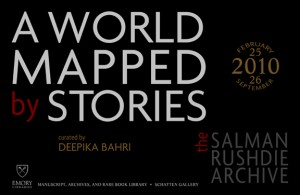My class this semester revolved around the idea of people, material artifacts, and information that are “born digital.” As my class blurb explains, “for people, this means that they are born into, and have only ever known, a world that prioritizes all forms of digitization; for materials and information, it means that they only exist in digital form.” After spending the first part of the semester discussing “Digital Natives” and how these “born digital” people navigate the digital world, we turned in the second unit to the concept of digital archiving. My inspiration for this class came in part from the Salman Rushdie exhibit at Emory University  this fall, which showcased highlights from the Booker-prize winning author’s archive (housed at Emory), with a particular focus on the “born digital” aspects of his work. My students visited the exhibit, and I used their experience to get them thinking about and discussing the changes being wrought on institutions and people who work on processing, storing, and displaying information that only exists in digital form.
this fall, which showcased highlights from the Booker-prize winning author’s archive (housed at Emory), with a particular focus on the “born digital” aspects of his work. My students visited the exhibit, and I used their experience to get them thinking about and discussing the changes being wrought on institutions and people who work on processing, storing, and displaying information that only exists in digital form.
As my students discovered at the Rushdie exhibit, archiving the work of writers who have composed the majority of their drafts on a computer leads to a different type of preservation effort, one that involves retrieving and parsing through the data on the author’s computer, creating visual maps of the files and organization of the writer’s documents, protecting any private information, and figuring out how to give researchers and scholars access to the digital data. In the exhibit, a section entitled ” Born Digital Rushdie” discussed the various challenges of creating a digital archive, and my students were interested in the ways that digital archives transform traditional notions of preservation and display. (You can read more about how Emory’s MARBL handled the challenge of processing one of the first literary digital archives here and watch videos describing how the archivists worked alongside computer experts to create a new methodology for preserving Rushdie’s digital materials here.)
The assignment to visit Rushdie’s archives laid the groundwork for a series of assignments that culminated in the students creating their own digital archives. Using the “StoryCorps” model of interviewing a friend or family member to create an “oral history,” the assignment asked students to find a person at Georgia Tech or someone from the local Atlanta community who had an interesting and unique story to share (you can read the detailed assignment here). In groups, students conducted interviews with people including the current Georgia Tech Student Body President, the first woman elected sheriff in Georgia (a student’s great-grandmother), a Hurricane Katrina survivor, a campus legend, a fourth-generation Tech student, several Deans and Tech alumni, and a star Georgia Tech football player. The students researched their subject, developed questions, and conducted twenty minute interviews. They then edited those interviews down to 5-7 minute excerpts to create a distinct and concise central narrative (like the StoryCorps segments that air on NPR). Finally, the students uploaded the interviews to Georgia Tech’s digital archiving program SMARTech (Scholarly Materials and Research at Tech). You can go and listen to them here!
While this assignment was designed to get students thinking about the ramifications of digital archiving (and the commensurate loss of materiality), it also challenged them to use communication skills that they don’t get much opportunity to practice – crafting thoughtful questions, steering and controlling the direction and pace of an interview, and editing an oral history to create a focused narrative while ethically representing the actual words and intention of the speaker. Interestingly, the students seemed divided on how they found the experience of working in a primarily oral/aural mode. Some said they found that editing and listening to the interviews forcing them to focus more intently on the words and made them realize how much they usually seek out a visual accompaniment. Others said that they felt like the interviews would have been enhanced by including a visual element, and, indeed, some groups opted to video the interview and then extract the audio track later. One student posted a blog entry about his desire to include the visual element of the interview, writing that “I viewed everything he [the interviewee] spoke to us about in my head as pictures we could flash up on a screen when he said this or that.”
The project, then, had some unexpected results, pushing students to think about their tendency as digital natives to depend on visual media to communicate and receive a message. But perhaps most significantly, students were asked to reflect on the value of oral histories and the potential of digital archiving to preserve and make available the narratives of ordinary people who have extraordinary stories to tell. And, in doing so, the students have left their own permanent digital legacy at Georgia Tech.
Please go and listen to some of their stories and let me know what you think!

Pingback: Tweets that mention TECHStyle | Blog | Salman Rushdie, StoryCorps, and SMARTech: Adventures in Digital Archiving -- Topsy.com
Pingback: TECHStyle | Blog | Semester Wrap-Up: Thinking about Feedback